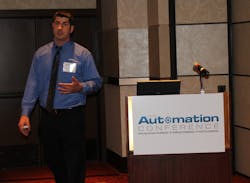Refineries are dangerous places. There are safety guidelines to adhere to and work within. It’s a large processing area, complete with accessibility challenges and often the need to work outside in the elements. And then there’s the sheer quantity of instruments.
I/O checkout and instrument checks are a big part of any project, and getting correct values from instrumentation is vital. A refinery project that system integrator Matrix Technologies was involved in showed just how challenging that could be—and how far industry had to go to take advantage of current technologies.
Though we might take mobile technologies like smartphones and tablets for granted in our own lives, a surprising amount of work in industry still relies on paper and pencil, data points written and rewritten and papers shuffled from field to office at a snail’s pace.
At The Automation Conference 2014, Ryan Drown, project leader/senior programmer, described how Matrix Technologies turned an instrumentation survey that was destined to take close to a year to complete into a 27-week project by introducing updated data entry and reporting methods. The use of tablets rather than traditional paper-based data gathering not only reduced project time, but introduced several other improvements, including better communication, reporting accuracy and safety.
The traditional approach to surveying instrumentation has a programmer or engineer at the panel, and a technician at the device, and the two radio back and forth. “If everything works well, it’s a very fast process. They go step by step by step. They verify that everything looks good with that device, then they go on to the next one,” Drown described. “But where the problem lies is when there are issues. And we know there are always issues.” The process becomes very slow, with a lot of back and forth, sometimes the engineer having to head out to the field to help troubleshoot.
“But what if we add a wireless access point to the PLC?” Drown asked. “Now the programmer is out with the technician at the device. It’s a much better way to go. He’s right there with him when a problem arises; he’s there to assist.”
Introducing a mobile device to the scenario carries multiple benefits in terms of safety, productivity, communication and problem resolution. But in its survey of 3,000 instruments at one refinery, there were several other benefits, Matrix found.
The survey goal was to confirm the field location and representation of P&IDs; check manufacturer, nameplate information and the condition of devices; and take photos of the instruments. A database would be created to log all of the data. The traditional approach was to send engineers out in the field with a stack of papers on clipboards, and hand record everything. The engineers would then go back to the office and turn over a stack of the coffee-stained, wind-torn papers to somebody who would enter the data into the system.
Of course, entering the data twice in this way provides twice the opportunity to get it wrong. “A better solution is to take a tablet PC out there, and have the person doing the survey actually enter the data directly in,” Drown said.
Matrix actually started the project with the traditional approach, and realized it was going to take 49 weeks to complete. After switching to the tablet method, the project took 27 weeks instead.
Saving time was just one benefit. Using iPads, the instruments were logged in real time, giving Matrix’s client the ability to access the data in real time, Drown noted. Progress tracking was in real time as well. “It was a really powerful way to do it vs. the old hand recording way.”
Since field personnel were already working on connected tablets, communication between the field and office became easier and faster through instant messaging. Instead of clipboards filled with drawings, PDFs could be retrieved from the cloud. In fact, there was no more need for blowing, stained, soaked documents; paper was replaced with iPads protected from the weather with hardened cases. Lost or illegible data became a thing of the past.
Of course, there are considerations. In choosing the iPad, Matrix was looking for such attributes as portability, adequate viewing area, long battery life, and relatively low cost. Also, to make use of tablets, the site needs to have Wi-Fi. In this case, the refinery had very good cell coverage. “But this can be an issue for some. Typically, IT folks want to control any networks out there,” Drown pointed out. “But you can really make a good case for it. Also, it’s a very temporary network—there for a week, maybe only a few days. It’s an isolated network, maybe just one PLC that it’s connected to. You can usually make a pretty strong argument for the use of that.”
About the Author
Aaron Hand
Editor-in-Chief, ProFood World

Leaders relevant to this article:
